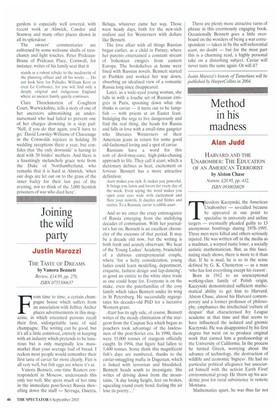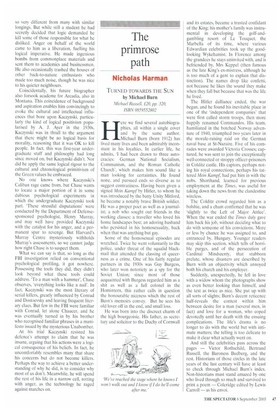Method in his madness
Alan Judd
HARVARD AND THE UNABOMBER: THE EDUCATION OF AN AMERICAN TERRORIST by Alston Chase Norton, £20.95, pp, 432, ISBN 0930020029 Theodore Kaczynski, the American Unabomber — so-called because he appeared at one point to
specialise in university and airline targets — eventually pleaded guilty to 13 anonymous bombings during 1978-1995. Three men were killed and others seriously injured. He was written off in the media as a madman, a warped rustic loner, a socially autistic mathematician. But, as this fascinating study shows, there is more to it than that. If he is mad, he is so in the sense defined by G. K. Chesterton — as a man 'who has lost everything except his reason'.
Born in 1942 to an unexceptional working-class family of Polish origin, Kaczynski demonstrated sufficient mathematical ability to get him to Harvard. Alston Chase, almost his Harvard contemporary and a former professor of philosophy, emphasises the intellectual 'culture of despair' that characterised Ivy League academe at that time and that seems to have influenced the isolated and gnomic Kaczynski. He was disappointed by his first degree but went on to produce original work that earned him a professorship at the University of California. In the process he turned Green, worrying about the advance of technology, the destruction of wildlife and economic 'bigness'. He had no particular political allegiance but associated himself with the activist Earth First! environmental group. He threw up his academic post for rural subsistence in remote Montana.
Mathematics apart, he was thus far not so very different from many with similar longings. But while still a student he had secretly decided that logic demanded he kill some of those responsible for what he disliked. Anger on behalf of the world came to him as a liberation, fuelling his logical imperative. He made ingenious bombs from commonplace materials and sent them to academics and businessmen. He also occasionally trashed the houses of other back-to-nature enthusiasts who made too much noise, though he was nice to his quieter neighbours.
Coincidentally, his future biographer also forsook academe for Arcadia. also in Montana. This coincidence of background and aspiration enables him convincingly to evoke the cultural and intellectual influences that bore upon Kaczynski, particularly the kind of logical positivism popularised by A. J. Ayer in the 1930s. Kaczynski was in thrall to the argument that there might be no logical basis for morality, reasoning that it was OK to kill people. In fact, this was first-year undergraduate stuff and philosophy had long since moved on. but Kaczynski didn't. Nor did he apply the same logical rigour to the cultural and chronological primitivism of the Green values he embraced.
No one knows where Kaczynski's Caliban rage came from, but Chase wants to locate a major portion of it in some dubious psychological experiments in which the undergraduate Kaczynski took part. 'These stressful disputations' were conducted by the Department of Defensesponsored psychologist, Henry Murray, and may well have provided Kaczynski with the catalyst for his anger, and a permanent spur to revenge. But Harvard's Murray Centre mysteriously withholds Murray's assessments, so we cannot judge how right Chase is to suspect them.
What we can say is that, so long as the FBI investigation relied on conventional psychological profiling, it got nowhere. Possessing the tools they did, they didn't look beyond what these tools could address. 'To a man with a hammer', Chase observes, 'everything looks like a nail'. In fact, Kaczynski was the most literary' of serial killers, greatly influenced by Conrad and Dostoevsky and leaving frequent literary clues. But few in the FBI were familiar with Conrad, let alone Chaucer, and he was eventually turned in by his brother who recognised familiar phrases in a manifesto issued by the mysterious Unabomber.
At his trial Kaczynski resisted his defence's attempt to claim that he was insane, arguing that his actions were a logical consequence of his beliefs. In fact, he uncomfortably resembles many that share his concerns but do not become killers. Perhaps the way to achieve a better understanding of why he did, is to consider why most of us don't. Meanwhile, he will spend the rest of his life in a narrow cell, rotting with anger, as the technology he raged against marches on.











































































 Previous page
Previous page